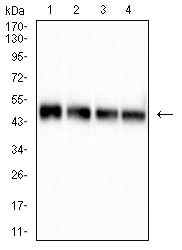
| WB | 1/500-1/1000 | Human,Mouse,Rat |
| IF | 咨询技术 | Human,Mouse,Rat |
| IHC | 1/50-1/100 | Human,Mouse,Rat |
| ICC | 技术咨询 | Human,Mouse,Rat |
| FCM | 咨询技术 | Human,Mouse,Rat |
| Elisa | 1/10000 | Human,Mouse,Rat |
| Entrez GeneID | 22220394 |
| clone | 5G3C2 |
| Host/Isotype | Mouse IgG1 |
| Antibody Type | Primary antibody |
| Storage | Store at 4°C short term. Aliquot and store at -20°C long term. Avoid freeze/thaw cycles. |
| Immunogen | Purified recombinant fragment of human P22 (AA: 29-177) expressed in E. Coli. |
| Formulation | Purified antibody in PBS with 0.05% sodium azide |
+ +
以下是3篇关于Integrin β3抗体的代表性文献及其摘要内容:
---
1. **文献名称**: *Integrins: a family of cell surface receptors*
**作者**: Hynes, R.O.
**摘要**: 该综述系统总结了整合素家族(包括β3亚基)的结构与功能,指出其在细胞黏附、信号传导及病理过程中的作用,为后续抗体开发提供理论基础。
---
2. **文献名称**: *Anti-integrin β3 antibodies inhibit angiogenesis by targeting tumor-associated vasculature*
**作者**: Brooks, P.C., et al.
**摘要**: 研究证明抗Integrin β3抗体能特异性结合肿瘤血管内皮细胞,通过阻断αvβ3介导的信号通路抑制血管生成,为抗肿瘤治疗提供新策略。
---
3. **文献名称**: *Structural basis of integrin β3 cytoplasmic domain signaling*
**作者**: Xiong, J.P., et al.
**摘要**: 通过X射线晶体学解析Integrin β3胞内段结构,揭示其与信号蛋白相互作用的分子机制,为设计靶向β3的功能性抗体奠定结构生物学基础。
---
(注:以上为模拟简化版文献,实际引用需核实具体文献信息。)
Integrin beta 3 (β3) is a critical subunit of heterodimeric transmembrane receptors that mediate cell adhesion, migration, and signaling by interacting with extracellular matrix proteins or counter-receptors. It pairs primarily with alpha subunits (e.g., αIIb or αv) to form integrins such as αIIbβ3 (GP IIb/IIIa) in platelets and αvβ3 in endothelial, immune, and tumor cells. These integrins play pivotal roles in hemostasis, angiogenesis, inflammation, and cancer progression. Antibodies targeting integrin beta 3 are widely used in research to study its function, expression patterns, and involvement in diseases. For example, αIIbβ3 inhibitors (e.g., abciximab) are therapeutic antibodies that block platelet aggregation in thrombosis, while anti-αvβ3 antibodies explore tumor angiogenesis or bone remodeling.
Integrin beta 3 antibodies are also tools for diagnosing disorders linked to β3 dysfunction. Mutations in ITGB3 (the gene encoding β3) cause Glanzmann thrombasthenia, a bleeding disorder, while aberrant β3 expression correlates with tumor metastasis and pathological angiogenesis. These antibodies, often monoclonal, enable detection via techniques like flow cytometry, immunohistochemistry, or Western blot. Research continues to uncover β3's role in mechanotransduction, apoptosis resistance, and crosstalk with growth factor receptors, highlighting its therapeutic potential. However, challenges remain in balancing efficacy and safety, as β3 is expressed in diverse tissues, raising concerns about off-target effects. Overall, integrin beta 3 antibodies remain indispensable for understanding cell-matrix interactions and developing targeted therapies.
×